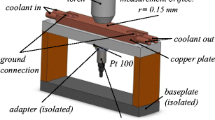Abstract
To date, several numerical models predicting the properties of TIG-arcs are available. Recently, effort has been put into testing the reliability of these models for varying process parameters by means of comparing plasma temperatures and arc voltages against measured data. However, from an engineering point of view, the goal of these models is to predict the properties of weld beads. Therefore, the heat input into and the pressure applied onto the workpiece have to be predicted. This paper deals with the comparison of measured arc pressure data and the results of an approach which couples a simplified cathode sheath model with an LTE arc model.








Similar content being viewed by others
References
Lowke, J. J.; Tanaka, M.: ‘LTE-diffusion approximation’ for arc calculations. In: Journal of Physics D: Applied Physics, Vol. 39 (2006), pp 3634–3643
Sansonnens, L.; Haidar, J.; Lowke, J. J.: Predictions of properties of free burning arcs including effects of ambipolar diffusion. In: Journal of Physics D: Applied Physics, Vol. 33 (2000), pp 148–157
Benilov, M. S.; Benilova, L. G.; Li, H. P.; Wu, G. Q.: Sheath and arc-column voltages in high-pressure arc discharges. In: Journal of Physics D: Applied Physics, Vol. 45, No. 35 (2012). - stacks.iop.org/JPhysD/45/355201
Lisnyak, M.; Cunha, M. D.; Bauchire, J.-M.; Benilov, M. S.: Numerical modelling of high-pressure arc discharges: matching the LTE arc core with the electrodes. In: Journal of Physics D: Applied Physics, Vol. 50 (2017). https://doi.org/10.1088/1361-6463/aa76d3
Lohse, M.; Siewert, E.; Hertel, M. et al.: Modelling of the cathode sheath region in TIG welding. In Welding in the World, Vol. 59 (2015), Issue 5, pp 705–711. https://doi.org/10.1007/s40194-015-0246-z
Shirvan, A. J.; Choquet, I.: A review of cathode-arc coupling modelling in GTAW. In: Welding in the World, Vol. 60 (2016), Issue 4, pp 821–835. https://doi.org/10.1007/s40194-016-0319-7
Benilov MS, Marotta A (1995) A model of the cathode region of atmospheric pressure arcs. In: J Physics D: Appl Physics 28(9):1869–1882. https://doi.org/10.1088/0022-3727/28/9/015
Cayla, F.: Modélisation de l’interaction entre un arc électrique et une cathode. Thesis. Universite Toulouse III–Paul Sabatier, 2008
Benilov MS, Cunha MD, Naidis GV (2005) Modelling interaction of multispecies plasmas with thermionic cathodes. Plasma Sources Sci. Technol 14. https://doi.org/10.1088/0963-0252/14/3/014
Baeva M (2017) Non-equilibrium modeling of tungsten-inert gas arcs. Plasma Chem Plasma Process 37(2):341–370. https://doi.org/10.1007/s11090-017-9785-y
Murphy AB (1997) Transport coefficients of helium and argon-helium plasmas. In: IEEE Transactions Plasma Sci 25-5:809–814
Hsu KC, Pfender E (1983) Analysis of the cathode region of a free-burning high intensity argon arc. J Appl Hysics 54(7):3818–3824. https://doi.org/10.1063/1.332606
Benilov MS (1995) The ion flux from a thermal plasma to a surface. J Physics D: Appl Physics 28:286–294
Devoto RS (1973) Transport coefficients of ionized argon. Phys Fluids 16:616–623. https://doi.org/10.1063/1.1694396
Tawara, H.; Kato, T.: Total and partial ionization cross sections of toms and ions by electron impact. In: Atomic Data and Nuclear Data Tables, Vol. 36 (1987), pp. 167–353
Bachmann, B. L.: Development of innovative thermal plasma and particle diagnostics. Thesis. Universität der Bundeswehr München, 2013
Shirvan AJ, Choquet I, Nilsson H (2016) Effect of cathode model on arc attachment for short high-intensity arc on a refractory cathode. J Phys D Appl Phys 49(48):485201. https://doi.org/10.1088/0022-3727/49/48/485201
Haidar J, Farmer AJD (1993) A method for the measurement of free cathode surface temperature for a high-current free-burning arc. Rev Sci Instrum 64(2):542–547. https://doi.org/10.1063/1.1144230
Mitrofanov NK, Shkol’nik SM (2007) Two forms of attachment of an atmospheric-pressure direct-current arc in argon to a thermionic cathode. In. Tech Phys 52(6):711–720. https://doi.org/10.1134/S1063784207060060
Sadek, A. A.; Ushio, M.; Matsuda, F.: Gas-tungsten-arc cathode and related phenomena. In: Trans JWRI Vol. 16(1) (1987), pp. 195–210. – http://hdl.handle.net/11094/12168
Author information
Authors and Affiliations
Corresponding author
Additional information
Recommended for publication by Study Group 212 - The Physics of Welding
Rights and permissions
About this article
Cite this article
Lohse, M., Trautmann, M., Siewert, E. et al. Predicting arc pressure in GTAW for a variety of process parameters using a coupled sheath and LTE arc model. Weld World 62, 629–635 (2018). https://doi.org/10.1007/s40194-018-0559-9
Received:
Accepted:
Published:
Issue Date:
DOI: https://doi.org/10.1007/s40194-018-0559-9




